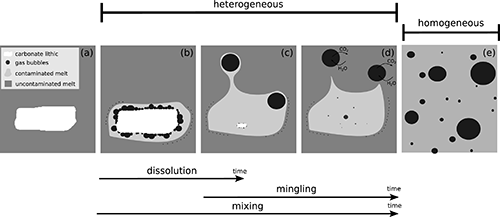Short-term magma-carbonate interaction: A modelling perspective

Colucci S., F. Brogi, G. Sottili, C.P. Montagna, P. Papale.
Earth and Planetary Science Letters, 628. https://doi.org/10.1016/j.epsl.2024.118592
Abstract
Short-term interaction of magma with crustal carbonates can affect a volcano’s eruptive style and drive even low-viscosity magmas toward large explosive eruptions. Only a few studies have focused on short-term magma-carbonate interaction under controlled laboratory conditions and the physical processes behind the experimental observations are still poorly understood. In this work, we present the first numerical modelling study of short-term magma-carbonate interaction and provide an interpretative framework for experimental and field observations. We developed thermodynamic and dynamic models for carbonate dissolution and mixing and mingling between contaminated magma pockets and host magma. We find that mixing and mingling can play a central role in modulating the efficiency of volatile exsolution. The increasing viscosity of the host melt slows down melt mingling and hence the mixing process, limiting volatile exsolution. Less efficient mixing and mingling could allow the fingerprints of short-term magma-carbonate interaction to be preserved in volcanic and intrusive rocks. Finally, we highlight that the mechanism and timescale of magma-carbonate interaction open a key question about the anomalous high mobility of CaO during carbonate dissolution.



Devi effettuare l'accesso per postare un commento.